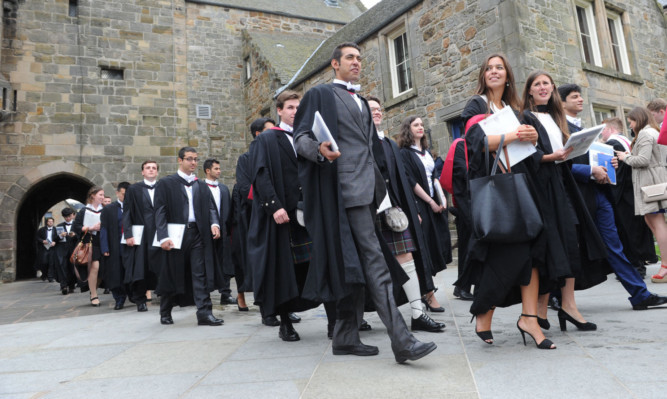The announcement of Higher and Advanced Higher results last week will hopefully have brought happy news to many Scottish school leavers, who had received conditional offers from universities here.
Tomorrow, when A-level results are published, perhaps there will be more rejoicing for the few Scottish schoolchildren who sit these exams.
More youngsters have applied for degree courses than in 2014 and congratulations must go to all the successful candidates, about to embark on this exciting journey of intellectual exploration.
But there will be many left behind, the doors of Scotland’s great universities closed to them because they have narrowly missed their desired grades.
In the past, these students would have been able to secure places through the clearing system but as a direct consequence of the SNP’s “free” tuition policy, this route is all but blocked to young Scots.
The lack of tuition fees in Scotland has created a funding shortfall, leading to a cap on the number of places offered to Scottish applicants. Universities are given only so much money from the government for each student and incur hefty fines if they exceed their quotas.
However, there is no limit to the number of fee-paying entrants they can accept, including those applying from the rest of the UK, who under the Nationalists’ terms pay up to £9,000 a year, or from countries outside the EU, who pay more than £10,000.
Fraction successful
This year, UCAS (the body which processes applications) reports that 14,190 Scottish leavers are “free to be placed in clearing” but only a fraction of those are likely to gain places this way.
There are about 250 courses in Scotland still open to Scottish undergraduates but this goes up to more than 2,500 for those applying from other parts of the UK or outside the EU. Last year, only 1,130 Scottish students found clearing places in Scottish universities.
I first heard about Scotland’s two-tier system in 2012, when our local newsagent’s daughter was trying to get into Dundee through clearing. There were courses available to everyone but Scottish students, it seemed.
That year, Aberdeen and Stirling too had no places for Scots through clearing, having used up their allocation of “free” places. Stirling published its clearing places on its website with this caution: “We do not have any places available for Scottish or EU students on any other courses. This is because places for these students are capped by the Scottish Funding Council and are already full at this time.”
So, even if Scottish students did better in their exams than their English or, say, American counterparts, they would be denied access on purely financial grounds. It is “an unfairness built into the system” said the National Union of Students.
Untouchable policy
Free tuition in Scotland has become one of the SNP’s untouchable policies, a powerful election tool designed to convince voters that it is more generous than the other parties, or the Westminster government.
However, as with free prescriptions which overburden the NHS but enable middle class pill poppers to indulge their vitamin habits for nothing free tuition does not lend help to those who most need it.
To pay around £2,000 per university student per year, the government has slashed 100,000 college places over the past three years, hitting working class children the hardest.
An Edinburgh University study in 2013 found the free tuition policy concentrated “resources on those who are already relatively advantaged” and better endowed English institutions spent more than three times as much as their Scottish peers on financial help for poor students thanks to their income from fees.
As a result, access to further education among poorer students reached a record high in England last year, proving that charging for courses is no barrier to a degree.
Students take out loans which they only repay when they start earning more than £21,000. After 30 years all debts are written off, so low earners may never repay their fees in full. This ensures that those most able to pay do, while the rest have a safety net.
No level playing field
In Scotland, the level playing field is anything but. It is most likely that those children from leafy suburbs who go to the best schools, or those privileged enough to be privately educated, will have scored the best exam marks. They will not have to resort to clearing.
But children who may be the first in their families to apply to university, who do not have the back-up at home with dissertations and who are taught in disruptive classrooms, will probably be the ones now competing against English and overseas students for places at Scottish universities.
There is no point in telling them their costs will be picked up by the kindly government because they won’t be going to university at all.
